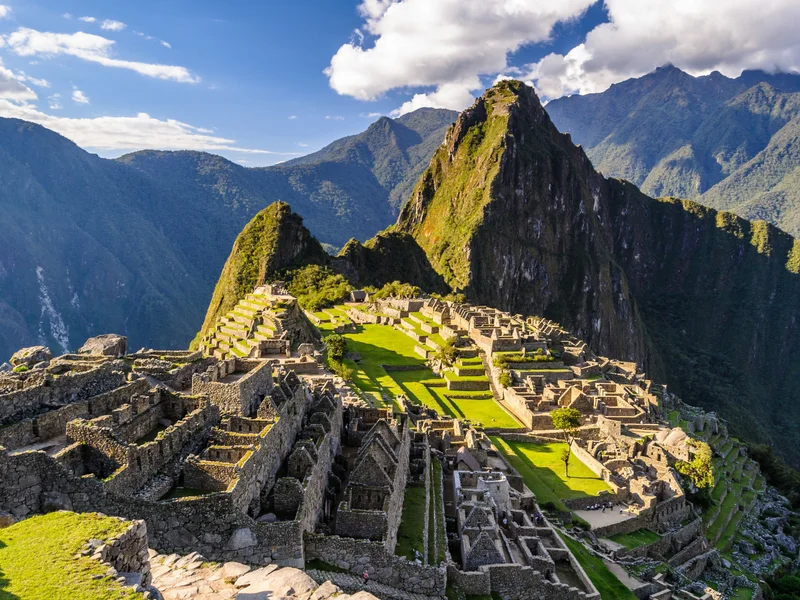UNESCO World Heritage Sites in Peru
Heritage Overview
Peru's UNESCO World Heritage sites represent some of South America's most remarkable pre-Columbian civilisations, colonial architecture, and extraordinary biodiversity across diverse ecosystems spanning Pacific coast through Andes mountains to Amazon rainforest. The country preserves exceptional archaeological evidence of sophisticated indigenous cultures alongside Spanish colonial heritage and unique natural environments. Ancient sites showcase remarkable architectural achievement, astronomical knowledge, and social organisation across multiple civilisations including Inca, Moche, Nazca, and Chavín cultures. Stone cities built in challenging mountain environments demonstrate sophisticated engineering, agricultural terracing systems, and religious complexes preserving distinctive artistic traditions. Geoglyphs and ceremonial centres document complex cosmological beliefs and artistic expression spanning millennia. Colonial heritage encompasses baroque churches, monasteries, and historic city centres demonstrating Spanish urban planning fused with indigenous building techniques and artistic contributions. Natural sites protect critical biodiversity hotspots with exceptional endemic species across cloud forests, páramo grasslands, and river systems. Together, Peru's heritage illustrates pre-Columbian achievements in architecture and engineering, Spanish colonial expansion, cultural syncretism creating distinctive artistic traditions, and extraordinary ecological diversity resulting from dramatic elevation changes creating multiple climate zones within relatively compact geographical areas.
Essential Information
Visa Requirements
Citizens of most countries including the United States, Canada, European Union, Australia, Japan, and most South American nations can enter Peru visa-free for tourism up to 90 days (183 days for some countries). Entry stamps are issued upon arrival. Passports must be valid for at least six months beyond entry date. Some nationalities require visas from Peruvian consulates. Extensions beyond initial periods require immigration office applications in major cities. Overstaying carries daily fines calculated at departure. Entry and exit stamps are mandatory—ensure you receive them at borders. Onward or return tickets may be requested. Keep entry documents throughout your stay.
Currency
The official currency is the Peruvian Sol (PEN). Credit and debit cards (Visa, Mastercard) are accepted in hotels, restaurants, shops, and tourist establishments in cities and major tourist areas. ATMs are widespread in urban centres and tourist destinations, dispensing soles with typical limits around 700-2,000 soles daily and charging fees for foreign cards. Cash is essential for markets, street vendors, smaller businesses, taxis, and rural areas. US dollars are accepted at some tourist establishments but at poor rates. Currency exchange is available at banks, casas de cambio, and airports. Bring sufficient cash for remote sites.
Language
The official languages are Spanish and Quechua (spoken by indigenous highland communities), with Aymara also holding official status. Spanish is the primary language throughout Peru. English proficiency is moderate in Lima and major tourist destinations like Cusco and Machu Picchu, where tourism professionals typically speak some English, but limited elsewhere. Younger generations in cities have increasing English exposure. Indigenous languages including Quechua and Aymara are spoken in highland regions and rural communities. Signage at major tourist sites includes English. Learning basic Spanish phrases significantly enhances travel experiences and facilitates communication. Peruvian Spanish has distinctive pronunciation and vocabulary.
Climate
Peru's diverse geography creates dramatically different climates across regions. The coastal region features desert climate with minimal rainfall, mild temperatures year-round (15-28°C), and frequent fog (garúa) in winter. The Andes highlands experience two seasons: dry season (May-September) with sunny days, cold nights (often below freezing), and minimal rain, ideal for trekking; and wet season (October-April) with afternoon rains and warmer temperatures. Amazon regions remain hot and humid year-round (25-35°C) with heavy rainfall November-April. The best visiting period for highland heritage sites is May-September (dry season), offering clear skies whilst avoiding wet season rains. Coastal areas are pleasant year-round. Pack layers.
